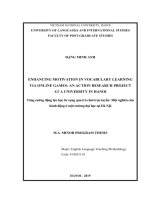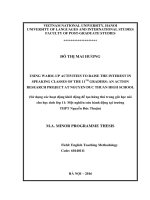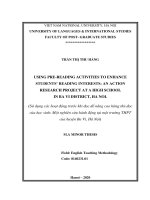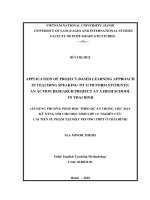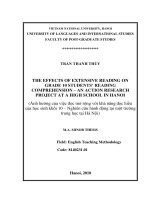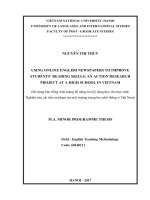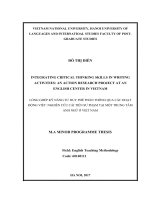Integrating critical thinking skills in writing activities an action research project at an english center in vietnam
Bạn đang xem bản rút gọn của tài liệu. Xem và tải ngay bản đầy đủ của tài liệu tại đây (920.01 KB, 68 trang )
VIETNAM NATIONAL UNIVERSITY, HANOI
UNIVERSITY OF LANGUAGES AND INTERNATIOAL STUDIES
FACULTY OF POST-GRADUATE STUDIES
ĐỖ THỊ DIỄN
INTEGRATING CRITICAL THINKING SKILLS IN WRITING
ACTIVITIES: AN ACTION RESEARCH PROJECT AT AN ENGLISH
CENTER IN VIETNAM
LỒNG GHÉP KỸ NĂNG TƯ DUY PHÊ PHÁN THÔNG QUA CÁC HOẠT
ĐỘNG VIẾT: NGHIÊN CỨU CẢI TIẾN SƯ PHẠM TẠI MỘT TRUNG TÂM
ANH NGỮ Ở VIỆT NAM
M.A MINOR PROGRAMME THESIS
Field: English Teaching Methodology
Code: 60140111
HA NOI, 2017
VIETNAM NATIONAL UNIVERSITY, HANOI
UNIVERSITY OF LANGUAGES AND INTERNATIOAL STUDIES
FACULTY OF POST- GRADUATE STUDIES
ĐỖ THỊ DIỄN
INTEGRATING CRITICAL THINKING SKILLS IN WRITING
ACTIVITIES: AN ACTION RESEARCH PROJECT AT AN ENGLISH
CENTER IN VIETNAM
LỒNG GHÉP KỸ NĂNG TƯ DUY PHÊ PHÁN THÔNG QUA CÁC HOẠT
ĐỘNG VIẾT: NGHIÊN CỨU CẢI TIẾN SƯ PHẠM TẠI MỘT TRUNG TÂM
ANH NGỮ Ở VIỆT NAM
M.A MINOR PROGRAMME THESIS
Field: English Teaching Methodology
Code: 60140111
Supervisor: Dr. Nguyễn Thị Minh Tâm
HA NOI, 2017
STATEMENT OF OWNERSHIP
I hereby declare that this thesis is my own work and that, to the best of my
knowledge, it contained no material previously published or written by another
person (except where explicitly defined in the acknowledgements), nor material
which has been submitted for award of any degree or diploma of a university or
other institution of higher learning.
Signature:…………………………………
Name: Đỗ Thị Diễn
Date: …………………………………..
i
ACKNOWLEDGEMENTS
In order to complete this thesis, I owe profound indebtedness to many people
their enthusiastic help during the conduct of my research.
I would like to give my sincere thanks to my supervisor, Dr. Nguyen Thi
Minh Tam, for her invaluable support, helpful guidance and considerable
encouragement, which plays a highly significant part in the completion of this
paper.
Besides, I would like to send my heartfelt thanks to twelve students in my
class, who enthusiastically participated in the data collection process. In fact,
without their help, I could not complete this thesis.
Also, I owe a great debt of gratitude to my parents and my husband, who
have constantly encouraged me during the time when I conducted my research
paper.
Last but not least, I would like to thank my readers for their interests and
comment on this study.
ii
ABSTRACT
Critical thinking skill is an important aspect in learning and teaching a
foreign language. Thinking skills lessons should be part of the curriculum if
students are to solve problems individually, cooperatively and creatively. Teachers
on the other hand must be conversant with relevant techniques needed for teaching
critical thinking skills. This study was conducted in an English class with 12 student
of grade 7 in the design of an action research. The hypothesis of this study is
integrating of critical thinking skills in writing activities can promote students‟
creative writing skills and learning motivation. The teacher used action research of
integrating the detailed requirements for student‟s use of critical thinking skills of
higher levels, or higher order thinking skills (HOTS) in writing activities. Class
observation, writing analysis and group interview were employed for data
collection. After data analysis, the finding was discussed to figure out what extent
student‟s use of HOTS in learning process to promote student‟s academic
achievement, creativity and motivation to learn.
iii
LIST OF ABBREVIATIONS
HOTS: Higher order thinking skills
EFL: English as a Foreign Language
L2: Second or Foreign Language
iv
LIST OF TABLES AND CHARTS
Table 1: The framework of integrating critical thinking skills in writing activities . 12
Table 2: HOTS integrated in writing activities ........................................................ 21
Table 3: HOTS levels as evidenced in their writing ................................................. 25
Chart 1: Students‟ levels of motivation throughout five weeks ............................... 23
Chart 2: Summary of students‟ writing analysis ...................................................... 25
v
TABLE OF CONTENT
STATEMENT OF OWNERSHIP ............................................................................ i
ACKNOWLEDGEMENTS ......................................................................................ii
ABSTRACT ............................................................................................................. iii
LIST OF ABBREVIATIONS.................................................................................. iv
LIST OF TABLES AND CHARTS ......................................................................... v
TABLE OF CONTENT ........................................................................................... vi
CHAPTER 1: INTRODUCTION ............................................................................ 1
1.1. Rationale for the study ......................................................................................... 1
1.2. The purpose of study ............................................................................................ 3
1.3. Significance of the study ...................................................................................... 3
1.4. Method of the study ............................................................................................. 4
1.5. Structure of the study ........................................................................................... 4
CHAPTER 2 :LITERATURE REVIEW ................................................................ 5
2.1. Theory of learning ................................................................................................ 5
2.2 Critical thinking skills and language skills development ..................................... 8
2.3 Writing skills and creativity ................................................................................ 10
2.4 Teaching critical thinking skills .......................................................................... 11
2.5 Review of previous study .................................................................................... 12
CHAPTER 3: METHODOLOGY ........................................................................ 14
3.1.Rationale for the use of action research .............................................................. 14
3.2.Data collection instruments ................................................................................. 15
3.2.1. Class observation ...................................................................................... 15
3.2.2. Writing analysis ........................................................................................ 15
3.2.3. Group interview ........................................................................................ 16
3.3. CONTEXT OF THE STUDY ............................................................................ 16
3.3.1. An overview on English center ................................................................ 16
3.3.2. Students .................................................................................................... 17
3.3.3. Teachers .................................................................................................... 17
vi
3.3.4. Materials ................................................................................................... 17
3.4. THE ACTION RESEARCH PROCEDURE ..................................................... 18
3.4.1. The action research process ...................................................................... 18
3.4.2. Research procedure .................................................................................. 19
CHAPTER 4: FINDINGS AND DISCUSSION ................................................... 23
4.1. Findings............................................................................................................... 23
4.1.1. Findings from observation........................................................................ 23
4.1.2. Findings from writing analysis ................................................................. 24
4.1.3. Findings from the interview ..................................................................... 28
4.2. Discussion .......................................................................................................... 30
4.2.1. Students‟ creative writing skills ............................................................... 30
4.2.2. Students‟ motivation in learning .............................................................. 36
CHAPTER 5: CONCLUSION AND SUGGESTIONS ....................................... 39
5.1 Recapitulation ..................................................................................................... 39
5.2. Implications for classroom practice ................................................................... 41
REFERENCES ........................................................................................................ 42
APPENDICES ........................................................................................................... I
vii
CHAPTER 1: INTRODUCTION
1.1. Rationale for the study
The practice of teaching critical thinking skills has recently attracted
increased interest in the field of the teaching of English as a Second or Foreign
Language (L2). It is no doubt to say that critical thinking is one of the most
important skills in learning and teaching a foreign language. Students are expected
to show evidences of critical thinking in their academic essays in the form an
argument and by demonstrating related skills such as analyzing, evaluating and
creating. This means that L2 teaching should no longer focus on the
compartmentalized teaching of language skills, but should embrace critical thinking
instead, although this is not going to be easy. Willian and Burden (1997) state that
critical thinking is cognitive process, in which the students are emerged to use their
minds to observe, think, categorize, and hypothesize. Therefore, it takes a long
journey to make the students become more critical and more independent. In
Western countries, integrating critical thinking has been significantly started from
elementary school while most Asian countries still consider critical thinking as a
challenging in the education. In fact, this can be related to the culture of Asian
learners who always believes that “silence is gold”. And the students tend to be
quite, passive and obedient in order to get information from their teachers.
Having been an English teacher for 5 years at some centers in Hanoi, I have
recently realized the fact that most of my students lack the ability to present their
own original views or opinions which are regarded as a key criterion of successful
academic writing. This clears that Vietnamese students are not often taught
argumentative or persuasive writing at schools. They rarely had a chance to write in
situations and write a topic in class, so their writing skill was even worse although
they were very good at doing exercises in structure forms. Students should be
trained to know how to share and communicate their ideas through writing because
this ability has been proved to be very important in education in general and in
1
higher education in particular. Writing skill is regarded as the means through which
many educational objectives and values are achieved and disseminated (Condon et
al., 2004).
I have a sense of the responsibility to train and equip my students with
critical thinking skills in their learning process because without comprehensive
practice in critical thinking, my students would miss the opportunity to be more
independently and self-confident to actively participate in the international
environment. Hence, teaching critical thinking is necessary to help my students
develop their ability to analyze, synthesize and evaluate problems. A statement by
Condon and Kelly-Riley (2004, p. 56) that “writing is a tool of thinking” means
writing is a real practice tool of critical thinking skills because “when we teach
students how to write, we are teaching them how to think‟. Not only do the students
need to have a good command of the language, they also need to be critical as they
examine viewpoints, facts and arguments and synthesize them. In Vietnam, the aim
of the new English curriculum for Secondary School includes developing student‟s
ability to use language ịn combination with other skills such as negotiating,
questioning, hypothesizing, critical thinking, and evaluating creatively. Among
these skills, students‟ creative and critical thinking skills and their ability to write
logically and intelligently are parts of the objectives of English teaching in Vietnam
nowadays. Therefore, I have always been wishing and trying to find the way to help
my students develop creative thinking and critical thinking skills through language
skills in my classes, and then apply these skills in their writing effectively. All the
things stated above drives me to the decision of conducting the research entitled
“An action research on integrating critical thinking skills in writing activities at
an English center in Vietnam”. Especially, the study will be conducted with the
focus on thinking skills of high levels which all students should learn and apply it to
solve unfamiliar problems, difficult questions, uncertainties and dilemmas. With
this action research, I hope to coin a different method in teaching of writing at my
workplace and also contribute a reference to the literature in this field.
2
1.2. The purpose of study
This research aims at integrating critical thinking skills in writing activities
to promote students‟ ability to express their view creatively in writing and engage
students in critical and creative learning activities in English classes. These
objectives can be achieved through the process of finding the answer to the
following questions:
-To what extent does the integration of critical thinking skills in writing activities
promote students’ creative writing skills?
- To what extent does the integration of critical thinking skills in writing activities
improve students’ learning motivation?
1.3. Significance of the study
The study focuses on how to integrate critical thinking skills in writing
activities to improve students‟ creative writing and learning motivation at an
English center in Vietnam. It can be useful contributions for both students and
teachers at my workplace. In term of useful contributions for teachers, the
researcher is expected to provide more lesson plan and scaffolding of integrating
critical thinking skills in writing activities. More interestingly, the research also
supports a useful teaching strategy with the applying critical thinking skills to the
diverse activities in writing skills. In addition, this thesis is hoped to serve as a
reliable and useful reference material about integrating critical thinking skills in
academic writing in Vietnamese pedagogical environment for other readers and
researchers in their further studies on related subjects. For students, the findings
and conclusions of the research are anticipated to encourage their use of critical
thinking skills to perform meaningful tasks. More importantly, they will to be
able to find news and means to solve their daily problems and make appropriate
decisions. Furthermore, students are trained to know how to share and
3
communicate their ideas through writing, which is an important goal of education
in general and in higher education in particular.
1.4. Method of the study
In order to achieve the aim, in this action research, qualitative method was
exploited with the facilitation of some statistical analysis. The data were collected
from a combination of three different instruments: classroom observation, writing
analysis and group interview.
1.5. Structure of the study
The study will be presented in four chapters: introduction, literature
review, methodology, data collection and discussion, and conclusion.
Chapter one, Introduction, introduces the rationale, the aims of the study,
scope of the study, method of the study, signification of the study and structure
of the study.
Chapter two, Literature Review, aims at reviewing some concepts as
well as the theory involving critical thinking, classroom activities that will be a
firm foundation for the study.
Chapter three, Methodology, describes the participants of the study, the
research questions, data collection and data analysis procedure.
Chapter four: Findings and Discussion – reveals the results of the study and
gives some suggestions.
Chapter five: Conclusion – summarizes the main points of the study.
Implications and suggestions for designing classroom activities to teach writing
skills with an integration of critical thinking skills development will be presented
in this part.
4
CHAPTER 2 :LITERATURE REVIEW
This chapter will present the theoretical background of the study, including
the insights of teaching writing and critical thinking skills. It reviews issues related
to both writing and critical thinking such as theory of learning, thinking skills and
language skills development, writing and creativity, and review of previous studies
on developing critical thinking skills.
2.1. Theory of learning
A theory is a scientifically acceptable set of principles offered to explain a
phenomenon. Theories provide frameworks for interpreting environmental
observations and serve as bridges between research and education (Suppes, 1974).
Research findings can be organized and systematically linked to theories. Without
theories, people could view research findings as disorganized collections of data,
because researchers and practitioners would have no overarching frameworks to
which the data could be linked (Learning Theories, Daleh Chunk, p.23). Integrating
may lack theoretical conceptualization which is necessary for making applications
of findings to other integration. Hence, it is integral to determine a theory which is
capable of orientating the study so that the information about a phenomenon can be
systematically unified so the findings from studies add to the body of knowledge
and deep understanding of the theoretical basis of the research topic. Additionally,
according to Chapelle (2003), theory is acted as the framework for the research on
some levels: from literature review of the study to the research questions as well as
development of methodology and the interpretation of data to gain the findings,
which then can be discussed to reach the results and conclusions of the study. For
these reasons, it was principal to clearly determine a theoretical framework for the
present study.
Learning theories are an organized set of principles explaining how
individuals acquire, retain, and recall knowledge. By studying and knowing the
different learning theories, we can understand better how learning occurs. The
principles of the theories can be used as guidelines to help select instructional tools,
techniques and strategies that promote learning. Although there are many different
5
approaches to learning, the three dominant learning theories are: Behaviorism,
Cognitive and Constructivism.
Behaviorism originated as a social science, the goal of which was to predict
and control behavior. Learning was manifested by a change in behavior, with an
emphasis on a connection between a stimulus and a response. From a behaviorist
perspective, the goal of education is to „ensure survival of human species, societies
and individuals‟ (Merriam and Caffarella, 1999, p.252). The main principles of
behaviorism have a visible impact on third level education, producing the
appearance in the curriculum of behavioral objectives or outcomes, the importance
of feedback, skills development and training, computerized and programmed
instruction, competency-based education, and constructive pre-alignment of
content, teaching methods and assessment
Cognitive theorists recognize that much learning involves associations
established through contiguity and repetition. They also acknowledge the
importance of reinforcement, although they stress its role in providing feedback
about the correctness of responses over its role as a motivator. However, even while
accepting such behaviorist concepts, cognitive theorist view learning as involving
the acquisition or reorganization of the cognitive structures through which humans
process and store information (Good and Brophy, 1990, p.187).
In Constructivist model, learning is viewed as a process of making meaning.
The learner interacts with experience and environment in the construction of
knowledge. The process is essentially learner-centred. However, while the
Constructivist theory encompasses a number of inter-related perspectives, theorists
„differ as to the nature of reality, the role of experience, what knowledge is of
interest, and whether the process of meaning making is primarily individual or
social‟ (Merriam and Caffarella, 1999, p.261).
In general, most definitions of learning involve a change in an individual's
knowledge, ability to perform a skill, or participate in an activity with other
individuals; there is considerable variation among the theories about the nature of
this change. All three theories contribute greatly to enlightening readers, especially
6
teachers, in their understanding about students learn and what learning strategies
they could use. For the teachers, when deciding which teaching strategies to use, it
is important to consider about the level of learner‟s knowledge, the thought
processing demands and the desired outcome. In my research, I choose Cognitive
theory to follow in my teaching process because of some reasons. Firstly, this
theory focuses on Educational problems and solutions. It emphasizes on the role of
learners‟ thoughts, beliefs, attitudes, and values. The ways that learners process
information determine what, when, and how they learn, as well as what use they
will make of the learning. In addition, to guiding students practice more in
Education and think to learn. Cognitive learning theory is best used to guide
learning when trying to build useful knowledge structures and teach clinical
reasoning. Cognitive, on the other hand, overcomes the key limitation of the
previous learning theory by viewing the learning as a thought processes behind the
observable behavior, which means that “Learning is viewed as a process of inputs,
managed in short-term memory, and coded for long-term recall” (George Siemens
2005, p.4). Furthermore, the Cognitive Learning Theory explains why the brain is
the most incredible network of information processing and interpretation in the
body as we learn things. Willian and Burden (1997) state that critical thinking is
cognitive process, in which the students are emerged to use their minds to observe,
think, categorize, and hypothesize. This theory can be divided into two specific
theories: the Social Cognitive Theory, and the Cognitive Behavioral Theory. In the
Social Cognitive Theory, there are
three variables: behavioral factors,
environmental factors (extrinsic), personal factors (intrinsic). According to Bloom
(1956), Cognitive Objectives are concerned with intellectual outcomes. The
classification system ranges from lower – level knowledge outcomes to higher-level
intellectual abilities and skills. The mental processes in the Cognitive System take
action from the knowledge domain, give people access to the information and
procedures in their memory and help them manipulate and use this knowledge.
7
2.2 Critical thinking skills and language skills development
Critical thinking is a fundamental skills for both language and literacy
success. Language and critical thinking grow together and nurture each other‟s
development.
Firstly, concerning about critical thinking skills, it involves the development
of dispositions which, among other things, include probing, inquisitiveness and
keenness of mind, zealous dedication to reason, and hunger or eagerness for reliable
information. Secondly, critical thinking refers to the development and application of
interrelated cognitive and meta-cognitive skills involved in solving problems,
understanding and expressing meaning, identifying relationships, assessing
credibility of statements, identifying elements needed to draw reasonable
conclusions, presenting the results of one‟s own reasoning coherently and selfconsciously monitor one‟s own cognitive actions. In the third place, critical thinking
comprises the development of habits of mind (Costa & Kallick, 2009:15-41).
Critical thinking is associated with quality thinking, it provides learners with more
skillful way of communicating with other people, acquiring new knowledge,
problem solving. In critical thinking approach to teaching both language skills and
thinking skills are of much importance, and are integrated. In fact, they are not
isolated anymore. The activities categorized as critical thinking activities are on
appearance writing, that is the final product is a piece of writing. In order to assess
student‟s critical thinking, teachers use academic writing as an effective tool in
learning process. There are mainly two kinds of ways for teaching critical thinking.
One is to set a special course to directly teaching critical thinking strategies and
rules, emphasizing the cultivation of students‟ critical thinking skills. The other is to
combine subject teaching with the training of critical thinking, focusing on
cultivating students‟ query and analytical thinking about the subject, and combining
the cultivation of critical thinking with individual quality. Fisher (2007) and Fisher
and Scriven (1997) argue that critical thinking should be seen as a basic academic
competency, akin to reading and writing, which needs to be taught. Beyer (2001)
claims that teaching thinking skills is worth considering for the crucial role it plays
in teaching, learning, and daily life. Swartz (2001) believes that teaching skillful
8
thinking not only enhances students‟ thinking abilities and learning in the content
areas but also greatly improves the quality of their lives, including their professional
work, after they leave school. Such thinking also improves their self-image and
their motivation to learn. Beyer (2001) indicates that mastery of at least four
thinking skills - comparing, classifying, sequencing, and predicting - is essential for
students to become effective readers, writers, and learners.
In term of the language skills, which are divided into two groups: productive
and receptive skills? “Both production and comprehension form the basis of
language teaching" (Richards, 1998), students language skills must be developed
through speaking, writing, listening and reading tasks or activities: These tasks must
be provided in a way that helps learners to "make transition from the classroom to
the real world". Tasks, such as pair work, role plays and group works which aim at
providing opportunities for optimal learning must be presented in the Second
Language teaching materials. These activities are facilitated by the teacher and then
completed by the students using their own resources of language. Through these
activities students are engaged in active and creative participation in classroom.
They are free to express their own knowledge, idea, opinions and experiences. Not
only does teacher‟s task help them become proficient in the English language, but
also make them become critical thinker. Studies about the characteristics of good
language learners have shown that good language learners make efforts to think in
their second language as soon as possible (Rubin, 1979). Carroll writes that one
characteristic of good language learners is that they try to understand the logic and
strategies that native speakers use in communicating (1977). Rubin concluded that
they are good at making guesses and inferences. (Rubin, 1979). It appears that good
language learners have at least some of the same characteristics of critical thinkers.
Perhaps in teaching critical thinking skills teachers can help them to become better
language learners.
To conclude, there is a strong link between critical thinking and language
skills development. It is necessary to integrate critical thinking into English
academic purposes and English second language classroom. Developing the critical
9
thinking skill help prepare to students who are learning English attend an
international community and their workplace in the future.
2.3 Writing skills and creativity
“Writing - the art of communicating thoughts of the mind - is the great invention of the
world…. Great, very great, in enabling us to converse with the dead, the absent, and the
unborn, at all distances of time and space, and great not only in its direct benefits, but its great
help to all other inventions.”
--Abraham Lincoln---
Writing skills are specific abilities which help writers put their thoughts into
words in a meaningful text and to convey their message. Hampton (1989) stated
that writers gain creativity when they can write their own ideas, not copy what has
already been written, so that they can be read and understood.
One of the expectations of students in essay writing is to demonstrate the
ability to develop an argument (Wingate, 2012). A good academic writer should be
able to present “evidence and arguments that he can then defend and from which he
can draw conclusions” (Alagozlu, 2007, p.119). In order to become an academic
writer, he is needed to support about argument writing skills which related to
critical thinking which is regarded as a part of the process of evaluating the
evidence collected solving or the results produced by thinking creatively ( Crowl et
al.,1997;Lewis &Smith, 1993). Furthermore, other scholars claimed that writing
ability depends on the ability to think clearly about substantive matters (Nickerson,
Perkins, & Smith, 1985).So, writing skills are invariably dependent on clarity of
thought. Moreover, Marzano (1991) suggested that “writing used as a mean to
restructure knowledge, improves higher-order thinking and in this context, writing
may provide opportunity for students to think through arguments and use higherorder thinking skills to respond to complex problems” (p.521). A statement by
Condon and Kelly-Riley (2004, p.56) that “writing is a tool of thinking” marks the
link between critical thinking and writing. McNamara et al. (2008) stress that,
although a challenge for many, writing well is of great importance for success in a
wide variety of institutions and professions. They share the same view that writing
skills are among the best predictor of student success at university, describing good
10
writing as writing that articulates ideas clearly, argues opinions, synthesizes
multiple perspectives, presents information effectively and consistently with wellchosen details, and avoids grammatical and mechanical errors. Similarly, Paul and
Elder (2006, 2007) describe „substantive writing‟, as that which has a clearly
defined purpose, makes a clear point, and supports it with specific information
which is clearly connected and coherent.
In general, though definitions of writing skills are numerous, all linguists
share the same idea that a good writing is related to creativeness, ideas clearly,
argues opinions, synthesizes and writing is a tool of thinking. There is also strong
link between critical thinking and academic writing skills developing.
2.4 Teaching critical thinking skills
Critical thinking skills are teachable and learnable, students should apply
these to their learning to solve unfamiliar problems. The development of critical
thinking skills are from low levels to higher levels, from lower order thinking skills
to higher order thinking skills (HOTS). In this study, HOTS were expected to be
integrated in different activities in learning processes in the writing classes. In this
study, the framework describing how thinking skills could be integrated into
learning activities was designed basing on Marzano‟s (2007) thinking skills
taxonomy. This framework was used as the reference to design prewriting, whilewriting and post-writing activities with detail requirements of thinking skill levels.
This framework was then used to be the reference for seeking the evidence of how
thinking skills, especially HOTS, were actually used by students.
The revised version of framework is designed as follows:
No.
CRITICAL THINKING SKILLS TOBE INTEGRATED IN
WRITING TASKS
IV.20
IV.19
Figure out a way to reach your goal under certain conditions
Figure out a way to solve a problem under certain conditions
IV.18
Figure out a way to solve the problem raised
IV.17
Decide the best solution for the problem raised
IV.16
Select the best among the following alternatives solution
III.15
Specify the argument/ideas on a certain issue
III.14
Generalize information from the given input data
11
MARZANO’S
TAXONYMY
UTILIZATION
(IV)
ANALYSIS
(III)
LEVEL
HIGHER ORDER
THINKING
SKILLS
III.13
Revise/edit the others‟/ ones‟ own argument s/ writing
III.12
III.11
II.10
Evaluate the other‟s idea / degree of seriousness of the problem
Organize ideas from the brainstormed ideas
Summarize the brainstormed ideas
II.9
Explain the ways in which the things described happens
II.8
Clarify how the things described happens
II.7
Illustrate the arguments / Represent the ideas in visual forms
II.6
I.5
I.4
Paraphrase the points logically
Describe the issue(s)
Name the issue(s)
I.3
Identify the issue(s) from the given input data
I.2
List the issue(s) from the given input data
I.1
Recognize the issue(s) from the given list
COMPREHENSION
(II)
LOWER –
ORDER
THINKING
SKILLS
RETRIEVAL
(I)
Table 1: The framework of integrating critical thinking skills in writing activities
2.5 Review of previous study
There have been a number of previous studies on the integration HOTS in
writing skills that researcher of this study has looked at and read. Some studies
carried out by both foreign researchers and Vietnamese researchers as follows:
Sarjit (2014) from Malaysia did an action research on “ESL Students‟
Perceptions of the use of HOTS in English Language Writing”. The study explored
the impact of using HOT skills in a secondary ESL writing classroom. The findings
from the focus group interviews revealed the following student perceptions: felt
engaged in active learning, experienced learner autonomy, developed their writing,
researching and personal skills. Furthermore, the study suggest that using HOTS in
ELS writing lessons facilitate students‟ writing ability and interest and it is
recommended that HOTS be explicitly infused in teaching and learning writing
activities.
Shaarawy (2014) attempted to investigate the effect of Journal Writing on
Students‟ Cognitive Critical Thinking Skills” with first year university students
(semester two) in one of the Egyptian private universities. The researcher based on
Bloom‟s taxonomy to design her own critical thinking assessment tool which was
used in the pre and posttests. Results indicated that journal writing had contributed
strongly to the development of the cognitive critical thinking skills of the
12
experimental group, which validates the new assessment tool and proposes a new
technique of developing critical thinking skills in Egyp.
In Vietnam, there are some studies on the implementation of critical
thinking (CT) in English writing. A study on “Critical Thinking‟s Effect on
Vietnamese Students‟ Writing Attitude and Performance: Action Research” by
Nguyễn Thị Khánh Thi in 2016 is one of the examples. The study shows the effect
of critical thinking skills on students‟ writing attitude and performance. The result
also indicates that students perform well in writing advice, introduction, and their
attitude to a problem, but are not good at giving suggestions and convincing people.
Nguyễn Thi Minh Tâm (2016) conducted a study to show that using HOTS
in learning process may promote student‟s learning in terms of academic
achievement, creativity, and motivation to learn. She provided a framework of
reference in designing HOTS integrated learning task in the linguistic course. Her
study proved that the importance of HOTS in learning process.
Another research is carried out by Ngô Thu Trang (2017) about an action
research project on “developing students‟ critical thinking skills through project –
based learning”. It provides an overview of the concepts of critical thinking and
projects – based learning, seek to investigating the effectiveness of using project –
based learning to develop critical thinking skills. The results show that projectbased learning has some positive effects on improving students‟ critical thinking
skills.
In conclusion, with regard to the literature review, using critical thinking
skills in teaching language skills is conducted by many teachers in many countries
in the world and also in Vietnam. Many studies were employed to develop critical
thinking skills which combined with language skills. They proved that critical
thinking skills could promote learner‟s academic achievement and their creativity.
However, integrating critical thinking skills and its implementation in education is
quite new in my English center. Hence, my thesis is carried out with purpose help
student apply HOTS in their learning in general, write effetely and creative in
particular.
13
CHAPTER 3: METHODOLOGY
This chapter provides the rationale for the use of an action research in this
study. In addition, it gives information about setting of the study, the participants,
and the research procedures as well as research instruments used in this study.
3.1.Rationale for the use of action research
Action research which was developed by Kurt Lewin in 1946 concerns itself
with taking action. According to Burns (2005), actions research “takes an explicitly
interventionist and subjective approach” (p.60). The research method has been
widely used in the investigation of human behavior and the social world. It emerged
as a new approach to research which is more directly relevant to the ongoing work
of practitioners. Wallace (1998) stresses „the systematic collection and analysis of
data relating to the improvement of some aspect of professional practice‟ (p.1)
Action research has had a great impact on educational research and literature.
It has been extensively used to research changes in teaching practice. Nunan (1989)
refers to action research as a form of „teacher-research…distinguished from other
forms of research by its practical focus. Teacher-research should grow out of the
problems and issues which confront teachers in their daily work‟ (pp.15-16). Field
(1997) considers action research as „a small-scale investigation undertaken by a
class teacher‟ (p.192).
From above statement, my research study with the purpose of changing from
my former traditional teaching practices to new practices critical thinking skills
approach is to evaluate the effectiveness of change on students‟ learning
performances and also to look for an appropriate method to teach writing skills for
Secondary students at Vkids center. I decided to use the action research model
Nunan (1992) which is composed of seven phases: Initiation, Preliminary,
Hypotheses, Intervention, Evaluation, Dissemination, Follow-up. Its fundamental
notion of changing or improving practice is relevant to the main goal of my enquiry.
14
3.2.Data collection instruments
To get a collection of sufficient, reliable and valid data for the study, a
combination of classroom observation which is conducted from teacher‟s take note,
writing analysis, and group interview were employed as the data collection
instruments. Thus, both qualitative and quantitative research methodology were
chosen for this action research.
3.2.1. Class observation
- Purpose: Class observation was used to collect data about how the
integration of critical thinking skills in writing activities to promote students‟
learning. Observation was also conducted to know whether integration activities
made any effects on students‟ motivation during the teaching and learning process.
- Procedure: the teacher takes note what is observed in her diary to examine
the overall class motivation, even each student because of the small number of
participants (12 students: 5 females and 7 males) here. The observation sheet (See
Appendix 1) adapted from Nunan (1989, p.110) was used to assess overall class
motivation generated by the application of integration activities during the
intervention. The observation was manifested by levels of learner interest,
enthusiasm, and persistence with writing activities, concentration and enjoyment
during class. Each item was scored on a scale of one (low) to five (high).
Observations were made for the whole 5 weeks while the experimental teaching
was carried out.
- Participants: 12 students of grade 7 throughout 5 writing sessions
3.2.2. Writing analysis
- Purpose: the writing analysis is used to assess type of HOTS. It is a useful
tool to collect data about the way students apply HOTS in their writing.
- Procedure: After each lesson, students are asked to write a piece of writing
as the result of using HOTS in learning process. Criteria for HOTS assessment were
adapted from the new version of the framework of HOTS by Marzano‟s (2007),
including four levels: Retrieval and Comprehension (lower level), Analysis and
15
Utilization (higher level). The marking scales range from 1 (lowest) to 4 (highest)
due to the proficiency of participants when performing the final writing (see
Appendix 4).
- Participants: all of the 12 students of grade 7 ( 7 Females and 5 Males).
Most students‟ English proficiency level is not very high because all these students
come from rural areas where they did not have many good enviroments to learn
English at their school.
3.2.3. Group interview
- Purpose: The group interview is conducted as a tool to collect more
information about how students used HOTS in their learning process and writing.
- Procedure: After all students‟ writing is analyzed, a group interview is
conducted with five students in the action class.
- Participants: this research selected 5 students (3 Males: S1, S3 and S5, 2
Females S4 and S12) for group interviewing: 2 students (S1 and S12) with the
significant improving as most of students in this class, 2 students (S4 and S5) with
the low mark in HOTS integrated tasks and low motivation during intervention, 1
student (S3) with unsteady motivation in these lessons.
3.3. CONTEXT OF THE STUDY
3.3.1. An overview on English center
This study is conducted at Vkids English center which was founded in 2013
and it has been developing and strengthening. It is opened to train English for all
students from 5 – 16 years. With modern equipment and professional staffs, Vkids
center attracts more students yearly with the amounts to 600 students so far. The
English Curriculum of the center is focus on both four skills: listening, speaking,
reading and writing. Furthermore, this place also train and equips to students‟
knowledge of mover test, flyer test and ielts examination. And it has become one of
the best centers for primary and secondary students at Quoc Oai district.
16

